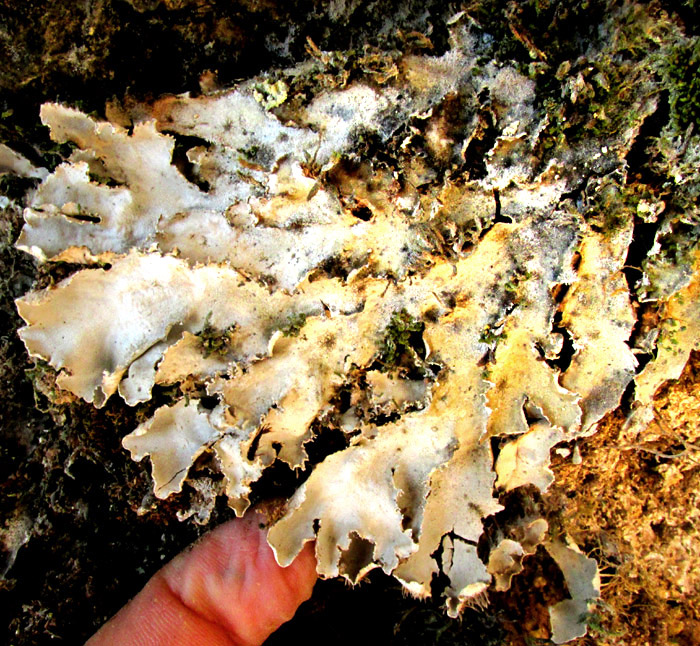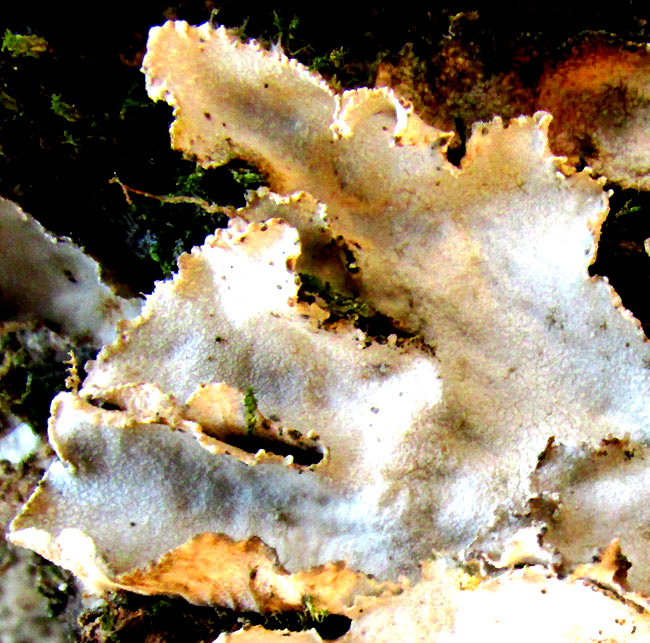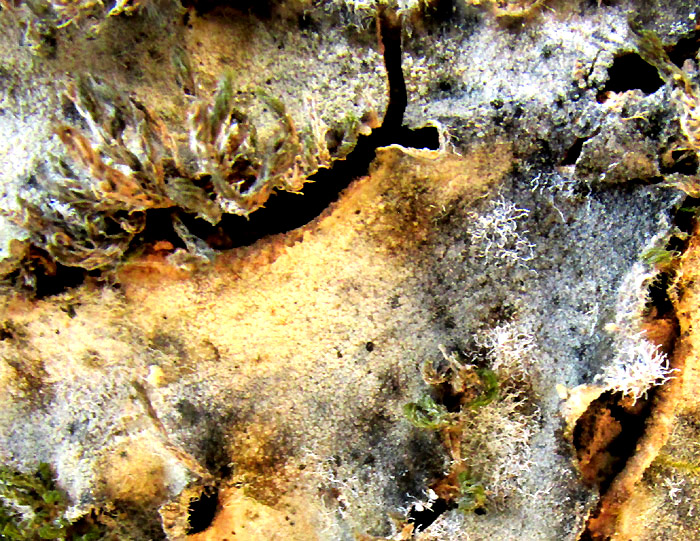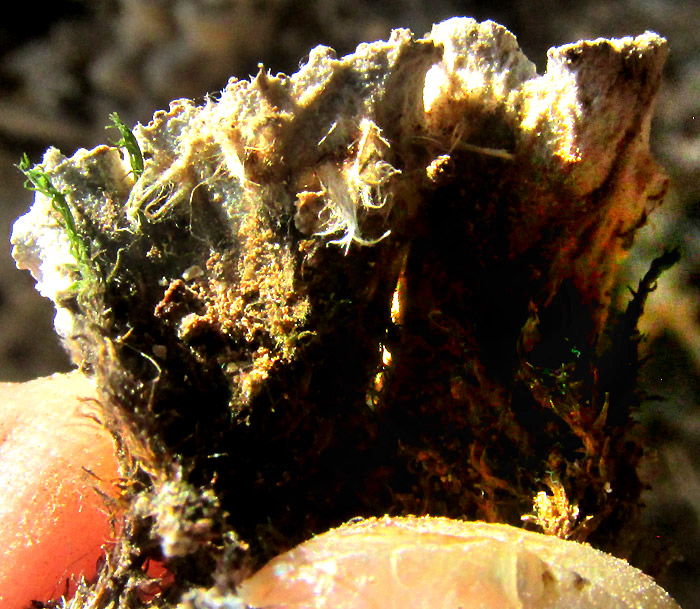Excerpts from Jim Conrad's
Naturalist Newsletter
entry from field notes dated May 6, 2023, on small gravel road descending into valley east of Curva de la Doctorcilla, which is on the road connecting Hwy120 and El Doctor; oak, pine and juniper forest on limestone bedrock; elevation ±2650m (8700 ft); Eastern Sierra Madre mountains of east-central Querétaro state, MÉXICO, (N20.88°, W99.62°)
SEA-STORM LICHEN, CETRELIA

On the steep slope of an old roadcut, on the sheltered, shaded wall of an eroded fissure cutting into a vertical, west-facing limestone face, the above foliose lichen caught my eye because its thalli were unusually broad and chalky-white. Up closer, more details emerged:

A conspicuous feature is the absence of spore-producing apothecia, which often look like small, thick-rimmed bowls, often raised on thick stems. The thalli's upper surfaces are sprinkled with tiny white pseudocyphellae, which are microscopic holes on the lichen's surface helping with gas exchange between the air and the lichen body. The more obvious field mark, though, is the thalli's warty margins.
The warty fringes are composed of soralia, which themselves contain soredia, which are powdery structures composed of fungal hyphae surrounding green algal cells. When a soredium loosens from its soredium, if it lands in a congenial habitat, it can grow into a new, asexually-produced lichen thallus. Also, in the above picture, note that a good bit of the thalli margins are loose from the rock surface, revealing white thallus undersurfaces, and a few tiny, rootlike rhizoids.

The topmost picture shows that on the lichen's older part, in the image's top, right corner, the thalli darken, develop holes and crinkle up. The above picture shows that area close up. Apparently that part of the lichen is being attacked by a white fungus. At the picture's top, left, the fungus spreads onto a cluster of green moss stems. At the picture's right, I'm unsure what the white, bushy items are; possibly the fungus's fruiting bodies. Whatever is going on here, from our safe perspective above the landscape, it's interesting, and all quite pretty.

The above image shows the bottom of a thallus, with some very small moss plants stuck to it. The thallus seems to have grown over mosses.
There's no field guide to lichens in Mexico, so identifying them usually begins with doing an image search on the Internet using keywords such as "líquenes foliáceos México" -- "foliose lichens Mexico." In such a way a group of species in the genus Cetrelia turned up, species in that genus being known as sea-storm lichens. Supposedly that name alludes to the waviness of the thalli's lobes, with frothlike soralia where the waves break.
The next step was to query the GBIF Cetrelia page -- on the map zooming in on central Mexico and clicking "explore" below the map -- to see which Cetrelia species have been documented in our area. In all of central Mexico there hadn't been many, and only three species had been observed more than once: Cetrelia chicitae, C.cetrarioides and C. olivetorum.
The problem was that pictures found on the Internet labeled as these species appeared to inconsistently represent key features; I couldn't get a fix on any of the three species.
The classic work on Cetrelia lichens is the 1968 study by William and Chicita Culberson entitled "The Lichen Genera Cetrelia and Platismatia (Parmeliaceae)." In that work, the authors speak of the "Cetrelia cetrarioides complex," Cetrelia cetrarioides being one of central Mexico's three most eligible names, and "species complexes" being a group of species so similar and closely related that it's unclear where the boundaries between them are, if they exist at all. The Culberson's Cetrelia cetrarioides complex included C. cetrarioides, C. chicitae and C. olivetorum, the same three species of Cetrelia most documented in central Mexico.
Of this complex the Culbersons write that fruiting bodies -- the apothecia unseen on our lichen -- commonly occur only in Cetrelia chicitae. They also remark that some individuals of Cetrelia chicitae and C. olivetorum are so similar that chemical tests are required for positive identifications. Also, they found that "The frequency with which Cetrelia olivetorum has been found mixed with C. cetrarioides in packets in herbaria indicates that these species often grow together in nature and doubtless have a very similar physiological ecology."
In short, not having the chemicals needed for testing, and working from pictures, the best I can do is to say that our lichens look like they belong to the genus Cetrelia, the sea-storm lichens.
But, seeing the rarity with which the genus has been documented in Mexico, that's still pretty good. Cetrelia species overwhelmingly have been observed in the northern temperate zone, and predominantly on trees, so here we have one on limestone rock, at an elevation where the name sea-storm lichen sounds funny.